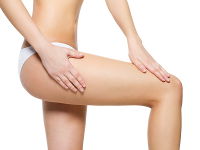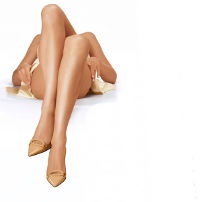Leg aesthetics
Legs are important part of female body image and aesthetics. Beautiful legs should have harmonious appearance and curves between buttocks and ankles. From front or back view slide bulge of the buttocks should decrease smoothly in the outer side until the knee and inner side may have a slide gap between two thighs around the upper part.
 Fat thigh: Fat accumulation around thighs are very common in women and sometimes stay as stabborn fat around upper outer thigh even in normal weighted individuals. If excess fat is the result of obesity weight loss is the best treatment option (and the most difficult option in certain individuals). Excess fat in women and men with normal body weight is best treated with liposuction. Liposuction can be done by plain vacuum pomp (suction assisted lipoplasty – SAL) or with the help of ultrasound (ultrasound assisted liposuction – UAL) or with the help of laser light (laser assisted liposuction – LAL). All of these methods are invasive procedures requiring some kind of anesthesia (general, sedation or local). There are also some non invasive methods to liquefy the fat without using operating room or anesthesia. These include:
Fat thigh: Fat accumulation around thighs are very common in women and sometimes stay as stabborn fat around upper outer thigh even in normal weighted individuals. If excess fat is the result of obesity weight loss is the best treatment option (and the most difficult option in certain individuals). Excess fat in women and men with normal body weight is best treated with liposuction. Liposuction can be done by plain vacuum pomp (suction assisted lipoplasty – SAL) or with the help of ultrasound (ultrasound assisted liposuction – UAL) or with the help of laser light (laser assisted liposuction – LAL). All of these methods are invasive procedures requiring some kind of anesthesia (general, sedation or local). There are also some non invasive methods to liquefy the fat without using operating room or anesthesia. These include:
- Radio-frequency (RF) devices: Some devices use electromagnetic waves used in microwave ovens and melts the fat externally without damaging skin.
- Ultrasound devices: Ultrasound devices focusing into the fat may melt it by heat without burning the skin.
- Laser devices: Some laser wavelengths may heat and melt fat without damaging the skin.
- Destroying the fat by cooling: Cooling devices are the most popular among non invasive fat emulsifiers. Fat under the skin is frozen externally without frostbiting the skin and then emulsifies and eliminates from the body in a few weeks.
Above mentioned non invasive fat reducing devices have limited clinical effect and not useful in overweight or obese persons.
Very thin thigh: One method to enlarge the thin thigh is injection of fat collected from the other parts of the body (if available).
Knees may have a slide outer bulge should contact to each other when standing but not have an inner bulge. The crus area ( part between knee and ankle) may have a convexity both inner and outer parts in the middle. However the circumference of the calf should not exceed average 36 cm and should not be less than average 33 cm. Concavity of the inner aspect of the thigh and knee is called as parenthesis legs and aesthetically disturbing. Some diseases, congenital deformities and bone problems may cause thin calves or parenthesis legs. Less frequent aesthetic problem of the female calves are muscular or thick calves.
Thick and heavy calf: If the reason is excess fat liposuction may have some benefit. However liposuction below the knee is a little bit more complicated than the above knee area and have a longer recovery period. If the enlargement of the calf is due to muscle hypertrophy botulinum toxin injections may reduce the muscle bulk without interfering walking if applied properly. The disadvantage of botulinum toxin is it works temporarily and should be repeated every 6 to 8 months for continuing effect.
 Thin calves and bow-legs: Treatment of parentheses or bow legs can be made by silicone implants. However silicone implants may have problems in long term like exclusion, hardening (capsule contraction), displacement and pain. The second treatment option is enlargement of the depressed or thinned areas with fat injections. Fat is obtained from the same individual from abdomen, flank, back, buttock or thighs. However in skinny individuals with minimal or no fat at all this method is not applicable.
Thin calves and bow-legs: Treatment of parentheses or bow legs can be made by silicone implants. However silicone implants may have problems in long term like exclusion, hardening (capsule contraction), displacement and pain. The second treatment option is enlargement of the depressed or thinned areas with fat injections. Fat is obtained from the same individual from abdomen, flank, back, buttock or thighs. However in skinny individuals with minimal or no fat at all this method is not applicable.
Prof. Ozgentas prefers autologous (taken from the same person) fat for calf augmentation.




Leave a Reply
Want to join the discussion?Feel free to contribute!